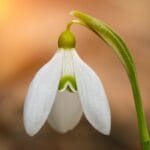More than just a harbinger of spring, the snowdrop flower whispers a language of hope, resilience, and rebirth, carrying centuries of symbolism and folklore. Imagine a world cloaked in winter’s silence, the earth seemingly asleep beneath a blanket of snow. Then, a whisper of green, a hint of white – the snowdrop emerges, a fragile yet defiant testament to life’s endurance.
A Botanical Marvel: The Delicate Yet Resilient Snowdrop
These delicate blooms, scientifically known as Galanthus – a name derived from the Greek words “gala” (milk) and “anthos” (flower) – are small, typically reaching only a few inches in height. Their bell-shaped flowers, a pristine white, droop gracefully from slender stems, often appearing to bow their heads in quiet contemplation. Native to Europe and Asia, snowdrops thrive in a variety of habitats, from woodlands and meadows to rocky slopes, often pushing through the last vestiges of snow in late winter or early spring.
Unlocking the Secrets: Snowdrop Symbolism Through the Ages
Perhaps the most enduring meaning attached to the snowdrop is that of hope and new beginnings. Emerging as they do when winter’s grip begins to loosen, they serve as a visual reminder that even in the darkest of times, brighter days await. This association makes them potent symbols of renewal and the promise of spring’s return. Their pristine white petals further contribute to their symbolism, representing purity and innocence.
Victorian Death Omens and the Evolution of Meaning
Interestingly, the snowdrop’s symbolism has not always been viewed so positively. For the Victorians, the snowdrop represented death and even considered it bad luck to bring snowdrops inside the home. The sight of a single snowdrop bloom was considered an omen of death. This darker association likely stems from the flower’s tendency to appear in graveyards, and from older myths that linked them to the underworld. This stark contrast highlights how the interpretation of natural symbols can shift and evolve across cultures and time periods.
Snowdrops in Myth and Legend
Throughout history, snowdrops have been woven into the fabric of folklore and mythology. The ancient Greeks wove them into the tale of Persephone, the goddess of spring, who was abducted to the underworld by Hades. It is said that as Persephone returned to the world above, bringing spring with her, snowdrops sprang up from the ground, marking her path.
In Christian tradition, snowdrops are often linked to Candlemas (February 2nd), a celebration of the presentation of Jesus at the Temple. They symbolize purity and the hope of light overcoming darkness.
Snowdrops in Art and Literature
The snowdrop’s delicate beauty and potent symbolism have captivated artists and writers for centuries. Poets like William Wordsworth and Christina Rossetti found inspiration in their resilience, using them to evoke themes of hope, renewal, and the ephemeral nature of beauty. Painters, too, have been drawn to their delicate forms, often depicting them emerging from the snow, a testament to nature’s quiet power.
Snowdrops Today: Gardens, Gifts, and Conservation
Today, snowdrops are beloved garden plants, prized for their early blooms and ability to bring a touch of magic to the winter landscape. They are often given as gifts, symbolizing hope, sympathy, or congratulations on a new arrival.
Sadly, some species of snowdrops are facing threats due to habitat loss and illegal collection. Conservation efforts are underway to protect these delicate heralds of spring and ensure their survival for generations to come.
The Enduring Allure of the Snowdrop
The snowdrop, though small in stature, carries a wealth of meaning and symbolism. Whether they evoke feelings of hope, resilience, or the bittersweet beauty of life’s cycles, these delicate flowers continue to captivate our imaginations. As you encounter them pushing through the frozen ground, take a moment to appreciate their quiet strength and the timeless message they carry: even in the depths of winter, hope blooms eternal.












